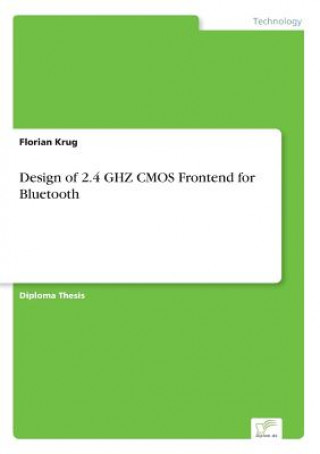
Kód: 02456544
Design of 2.4 GHZ CMOS Frontend for Bluetooth
Autor Florian Krug
Diploma Thesis from the year 2001 in the subject Electrotechnology, grade: 1,0, Technical University of Munich (unbekannt), language: English, abstract: Inhaltsangabe:Abstract:§The Bluetooth wireless technology is the worlds new s ... celý popis
- Jazyk:
 Angličtina
Angličtina - Vazba: Brožovaná
- Počet stran: 80
Nakladatelství: Diplom.de, 2001
- Více informací o knize

Mohlo by se vám také líbit
-

Clinical Cases and OSCEs in Surgery
1267 Kč -

Copyright Law and the Distance Education Classroom
2819 Kč -

Changing Eating and Exercise Behaviour
2482 Kč -

Borderlands
779 Kč -

Anatomy of a Rose
501 Kč -

Gadget Geeks
443 Kč -

Mob and the City
708 Kč -

Airways Obstruction
1665 Kč -

Differential Equations, Chaos and Variational Problems
5060 Kč -

10 Years Southeast European Cooperative Initiative
1424 Kč -

Beste Freunde
223 Kč -

Mediation als aussergerichtliches Konfliktlösungsmodell
1125 Kč -

Magenta Und Solferino - Band 3
1578 Kč -

Der kleine tapfere Bär
198 Kč
Darujte tuto knihu ještě dnes
- Objednejte knihu a zvolte Zaslat jako dárek.
- Obratem obdržíte darovací poukaz na knihu, který můžete ihned předat obdarovanému.
- Knihu zašleme na adresu obdarovaného, o nic se nestaráte.
Více informací o knize Design of 2.4 GHZ CMOS Frontend for Bluetooth
Nákupem získáte 206 bodů
 Anotace knihy
Anotace knihy
Diploma Thesis from the year 2001 in the subject Electrotechnology, grade: 1,0, Technical University of Munich (unbekannt), language: English, abstract: Inhaltsangabe:Abstract:§The Bluetooth wireless technology is the worlds new short-range RF transmission standard for small form factor, low-cost, short-range radio links between portable or desktop devices. The technology promises to eliminate the confusion of cables, connectors and protocols confounding communications between today high tech products.§In the first step a 2.45 GHz Low Noise Amplifier (LNA), intended for use in a Bluetooth receiver, has been designed in a standard 0.18 um CMOS process. The amplifier provides a simulated switchable forward voltage gain of +16 / -7.7 dB with a simulated noise Figure (NF) of only 3 dB while drawing 2.8 mA from a 1.8 V supply. The die area of the LNA (pads included) is 0.79 mm2.§In the second step a 2.45 GHz Power Amplifier (PA), also intended for the Bluetooth standard, has been designed in the same 0.18 um CMOS process as for the LNA. The class-A PA achieves a simulated forward gain (S21) of 23 dB and a simulated output 1 dB compression point (P1dB ) of 5.5 dBm, with a power-added efficiency (PAE) of 23 % while drawing 15.8 mA from a 1.8 V supply. The die area of the PA (pads included) is 2.1 mm2.§Inhaltsverzeichnis:Table of Contents:§1.Introduction1§1.1Motivation1§1.2Organization2§2.The Bluetooth standard3§2.1Bluetooth as branding-name3§2.2Bluetooth RF requirements4§2.3System design4§2.3.1Receiver architectures4§2.3.2Transmitter architectures6§3.RF CMOS technology9§3.1The foundry9§3.1.1Technology overview9§3.1.2Process Characteristic9§3.2Design Flow10§3.2.1Cadence10§3.2.2SpectreRF10§4.Integrated spiral inductors11§4.1View and physical dimension of spiral11§4.2Model for on-chip spiral inductors12§5.Low Noise Amplifier13§5.1Architecture choices13§5.1.1Recent studies13§5.1.2LNA Architectures13§5.1.3Architecture properties14§5.1.4Architecture choice14§5.2A little piece of theory15§5.2.1Standard MOS noise model15§5.2.2Noise Figure16§5.2.3Input impedance16§5.2.4Voltage Gain18§5.2.5Stability19§5.2.6Noise Figure20§5.3Design approach for the LNA21§5.3.1Circuit topology21§5.3.2RF circuit design strategy21§5.3.3DC operating point design strategy23§5.3.4Input matching24§5.3.5Voltage gain25§5.3.6Noise Figure26§5.3.7Stability27§5.3.8LNA core schematics with component values28§5.4Design approach for the attenuation path of the LNA29§5.4.1Circuit Topology29§5.4.2Switching network29§5.4.3Input matching31§5.4.4Attenuation32§5.4.5Switchable LNA schematics with component values33§5.5Summary of simulation33§5.6Layout34§5.7Measurement approach36§5.7.1Simulation results36§5.7.2Summary of simulation39§6.Power Amplifier41§6.1Architecture choices41§6.1.1Recent studies41§6.1.2PA classification42§6.1.3Architecture choice42§6.2A little piece of theory44§6.2.1Efficiency definitions44§6.2.2Class-A power amplifier44§6.2.3Loadline theory46§6.3Design approach for the PA46§6.3.1Design approach for the output stage46§6.3.2Design approach for the interstage matching49§6.3.3Design approach for the input49§6.3.4Stability50§6.3.5PA schematics with component values50§6.4Measurement approach52§6.4.1Simulation results52§6.4.2Summary of simulation results55§6.5Layout55§Bibliography57§Abbreviation and symbols61§Conceptual formulation63§Curriculum vitae65
 Parametry knihy
Parametry knihy
Zařazení knihy Knihy v angličtině Technology, engineering, agriculture Energy technology & engineering Electrical engineering
2060 Kč
- Plný název: Design of 2.4 GHZ CMOS Frontend for Bluetooth
- Autor: Florian Krug
- Jazyk:
 Angličtina
Angličtina - Vazba: Brožovaná
- Počet stran: 80
- EAN: 9783838641942
- ISBN: 3838641949
- ID: 02456544
- Nakladatelství: Diplom.de
- Hmotnost: 113 g
- Rozměry: 210 × 148 × 5 mm
- Datum vydání: 05. June 2001
Oblíbené z jiného soudku
-

Further Electrical and Electronic Principles
1850 Kč -

Fitzgerald & Kingsley's Electric Machinery
8297 Kč -
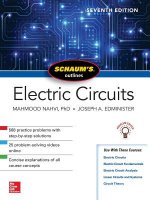
Schaum's Outline of Electric Circuits, Seventh Edition
437 Kč -
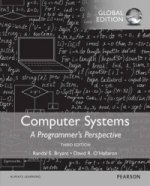
Computer Systems: A Programmer's Perspective, Global Edition
2093 Kč -

Digital Image Processing, Global Edition
1970 Kč -

Electric Motors and Drives
1575 Kč -
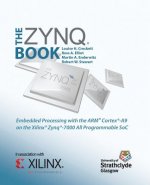
Zynq Book
1168 Kč -

Requirements for Electrical Installations, IET Wiring Regulations, Eighteenth Edition, BS 7671:2018+A2:2022
3770 Kč -
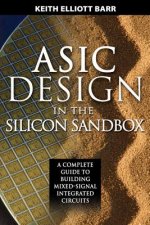
ASIC Design in the Silicon Sandbox: A Complete Guide to Building Mixed-Signal Integrated Circuits
4490 Kč -

Electrical Power Transmission and Distribution
3631 Kč -

Electrical Engineering Textbook
1662 Kč -

Switching Power Supply Design and Optimization, Second Edition
4301 Kč -

Power Electronics: Devices, Circuits, and Applications
2610 Kč -

Control System Design
797 Kč -

Overhead Power Lines
9241 Kč -

Applied Electromagnetics - Early Transmission Lines Approach
8848 Kč -

Electrical Engineering 101
887 Kč -

Build Your Own Electric Vehicle, Third Edition
716 Kč -

Feedback Control of Dynamic Systems, Global Edition
2574 Kč -

Common Lisp: A Gentle Introduction to Symbolic Computation
715 Kč -

Nikola Tesla
655 Kč -

Magnetic Current
217 Kč -

Computer Networks: Pearson New International Edition
1808 Kč -

Switching Power Supplies A - Z
1733 Kč -

Troubleshooting and Repairing Major Appliances
1350 Kč -

Principles and Applications of Lithium Secondary Batteries
4731 Kč -

Digital System Design with FPGA: Implementation Using Verilog and VHDL
2865 Kč -

Nikola Tesla
952 Kč -

Anova Sous Vide Cookbook
693 Kč -
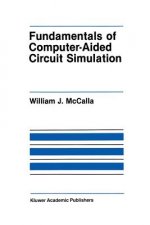
Fundamentals of Computer-Aided Circuit Simulation
5060 Kč -

ULTIMATE Tesla Coil Design and Construction Guide
1119 Kč -

Electrician's Trade Demystified
819 Kč -

Electrical Engineering: Know It All
2107 Kč -
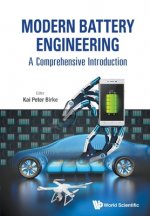
Modern Battery Engineering: A Comprehensive Introduction
1821 Kč -

Fuel Cells - Data, Facts and Figures
5335 Kč -

Computer Organization and Design RISC-V Edition
2844 Kč -
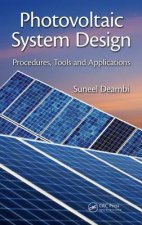
Photovoltaic System Design
4470 Kč -

Switching Power Supply Design, 3rd Ed.
3762 Kč -
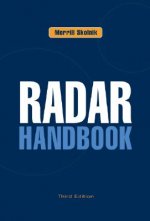
Radar Handbook, Third Edition
7977 Kč -

Requirements for Electrical Installations, IET Wiring Regulations, Eighteenth Edition, BS 7671:2018
3317 Kč -
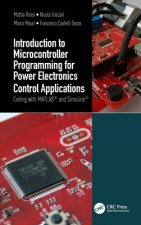
Introduction to Microcontroller Programming for Power Electronics Control Applications
1881 Kč -

Digital Control of High-Frequency Switched-Mode Power Converters
3245 Kč -

Electric Motor Maintenance and Troubleshooting
1485 Kč -

Introduction to Electrical Installation Work
1517 Kč -

Transformer Engineering
7094 Kč -

Advanced Electrical Installation Work
1682 Kč -

Industrial Communication Systems
1926 Kč -
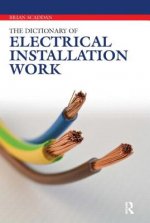
Dictionary of Electrical Installation Work
1517 Kč -

Grid-Connected Photovoltaic Power Generation
2876 Kč
Osobní odběr Praha, Brno a 12903 dalších
Copyright ©2008-24 nejlevnejsi-knihy.cz Všechna práva vyhrazenaSoukromíCookies



 Vrácení do měsíce
Vrácení do měsíce 571 999 099 (8-15.30h)
571 999 099 (8-15.30h)